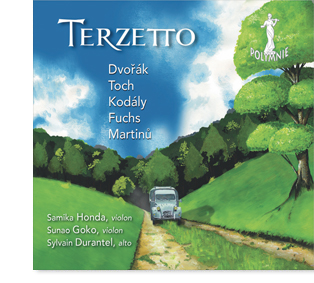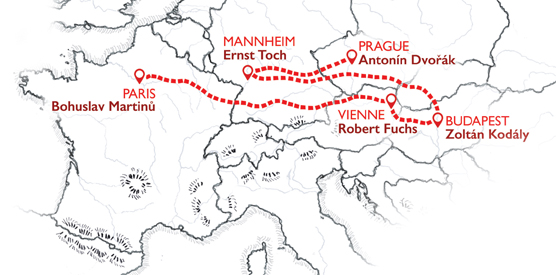 |
|||||

Terzetto
Samika
Honda, violon
•
Sunao Goko, violon
•
Sylvain Durantel, alto
POL 304 171
Commander
sur Clic Musique !

Terzetto
Antonín Dvorák (1841-1904)
Terzetto en do majeur, op. 74, B 148
Ernst Toch (1887-1964)
Sérénade, op. 25
Zoltán Kodály (1882-1967)
Sérénade, op. 12
Robert Fuchs (1847-1927)
Premier Trio, op. 61 n° 1
Bohuslav Martinu (1890-1959)
Serenata II, H 216
Pianiste et philosophe, Ernst Toch, expatrié en Californie lors de la Seconde Guerre mondiale, a composé les musiques de nombreux films d’Hollywood. Il aimait les œuvres très originales, comme la Fuge aus der Geographie, Big-Ben, ou encore son Quatuor op. 98 pour hautbois, clarinette, basson et alto. La Sérénade a été écrite à la manière du poète et peintre allemand Carl Spitzweg.
Zoltán Kodály ne connaissait pas le Terzetto de Dvořák, quand, plus de trente ans après la création de celui-ci, il écrivit la Sérénade op. 12. Il avait déjà esquissé un trio pour deux violons et alto alors qu’il était tout jeune. Alliant esprit folklorique et harmonies originales, la Sérénade séduit Bartók : « Nous nous retrouvons dans un monde féerique jamais imaginé auparavant. »
Brahms disait « Robert Fuchs est un musicien splendide, tout est si beau, si habile, si charmant...» Chef d’orchestre, organiste, Fuchs forma au Conservatoire de Vienne d’éminents compositeurs tels que Enesco, Korngold, Mahler, Sibelius, Strauss, Wolf, Zemlinsky... Son Premier Trio op. 61 est typique de l’esprit viennois de la fin du XIXème siècle.
La Serenata II, H. 216 fait partie du cycle de quatre sérénades écrites par Bohuslav Martinů en 1932 à Paris. Débordant d’enthousiasme et d’énergie, elle offre une spontanéité touchante. Dix ans plus tard, Martinů reviendra vers l’association violon - alto, avec les Trois Madrigaux H. 313.

Antonín Dvorák wrote the Terzetto op. 74 to please his friends Josef Kruis and Jan Pelikan. This masterpiece of chamber music was created by Jan Buchal, a lawyer, Jaroslav Stastny, a doctor of medicine, and Dvorák himself on the viola.
Pianist and philosopher Ernst Toch composed the music for many Hollywood films. He liked the very creative works. The Serenade was written in the manner of the German poet and painter Carl Spitzweg.
Zoltán Kodály didn’t know Dvorák’s Terzetto when, more than thirty years after its creation, he wrote the Serenade op.12. Combining folklore and original harmonies, the Serenade seduces Bartók : «We find ourselves in a fairy world never imagined before.»
Brahms said «Robert Fuchs is a splendid musician, everything is so beautiful, so clever, so charming...» Conductor and organist, Fuchs trained at the Vienna Conservatory such outstanding composers. His First Trio op. 61 is typical of the Viennese spirit of the late 19th century.
The Serenata II, H. 216 is part of the cycle of four Serenades written by Bohuslav Martinů in 1932 in Paris. Full of enthusiasm and energy, it offers a touching spontaneity.
Sunao Goko a remporté de nombreux prix prestigieux, dont le Concours international Yehudi Menuhin 2006, et le Concours International Tibor Varga 2013. Se produisant très régulièrement en soliste avec orchestre, il a enregistré plusieurs albums en sonate, dont La Belgique avec Hiroshi Kato, et les Sonates de Brahms avec Haruko Ueda. Il joue le Stradivarius Banat de 1682.
Membre de l’Ensemble Monsolo et du Quatuor Alérion, Sylvain Durantel est second soliste de l’Orchestre de l’Opéra national de Lorraine. Il a étudié avec Françoise Gnéri et Bruno Pasquier au CNSM de Paris. Il est à l’origine du programme de création contemporaine La Cuisine à l’alto [POL 301 121]. Il joue un alto Patrick Charton de 1997.
Sunao Goko has won many prestigious prizes, including the 2006 Yehudi Menuhin International Competition, and the 2013 Tibor Varga International Competition. Performing very often as a soloist with orchestras, he has recorded several sonata albums, including La Belgique with Hiroshi Kato, and Brahms Sonatas with Haruko Ueda. He plays the Banat Stradivarius of 1682.
Member of the Monsolo Ensemble and the Alérion Quartet, Sylvain Durantel is Viola second soloist of the Opéra national de Lorraine Orchestra. He studied with Françoise Gnéri and Bruno Pasquier at Paris CNSM. He is behind the creation of La Cuisine à l’alto [POL 301 121]. He plays a 1997 Patrick Charton viola.
![]()
Accueil | Catalogue
| Interprètes | Instruments
| Compositeurs | CDpac
| Stages | Contact
| Liens
• www.polymnie.net
Site officiel du Label Polymnie • © CDpac • Tous droits
réservés •


